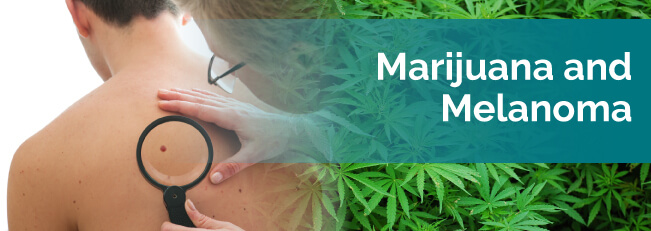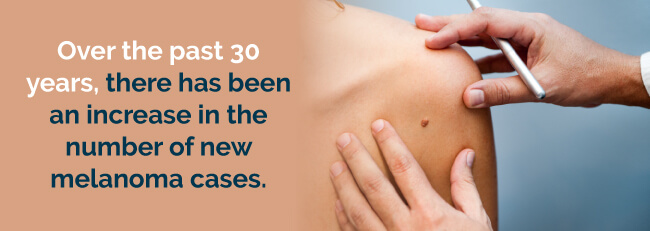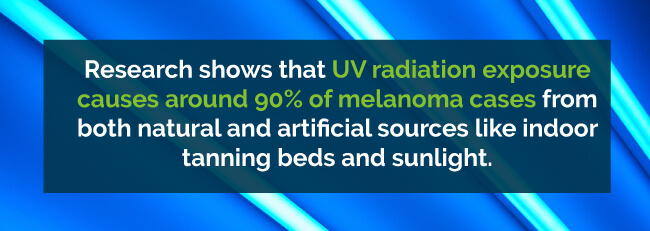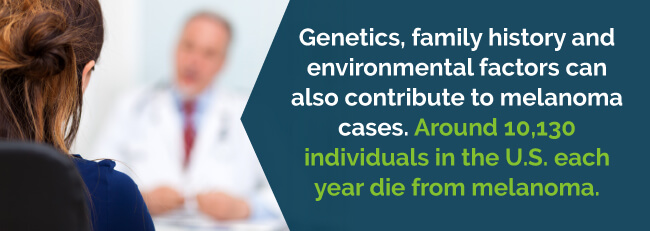
The largest organ of your body is your skin. It protects you against sunlight, heat, infection and injury. It also stores fat, water and vitamin D and controls your body temperature. Over the past 30 years, there has been an increase in the number of new melanoma cases. Medical marijuana for melanoma may be showing some promise in both killing cancer cells and preventing new growth.


Melanoma patients have found success with cannabis oil. Also, international research has identified that medical cannabis is a powerful anti-cancer agent in animals. A 2015 Journal of Investigative Dermatologystudy found THC and CBD treatment helped reduce melanoma cell viability.
Researchers also found that combining small amounts of THC with CBD intensifies the anticancer effects. The cannabis and melanoma treatment destroyed the cancerous skin cells, but not the normal healthy cells.
A 2015 study examined how effectively cannabinoids could stimulate melanoma cell death. The team took both in vitro and in vivo approaches, meaning they analyzed both cell samples and cells in living beings. When they treated melanoma cells with THC, cell death and turnover rates increased. The cancer cells also had less viability after exposure, making them more susceptible to treatment.
The researchers also examined how autophagy, or cell “recycling,” came into play in THC-related cell death. When they used both THC and chloroquine, a potential cancer treatment, THC’s effects stopped. Chloroquine inhibits autophagy, so the fact that it interferes with THC’s results shows autophagy could be involved.
When the team tried treating live subjects with cannabinoids, they found similar success. They dosed mice with either a mixture of equal amounts of CBD and THC or pure THC. To see how the compounds performed compared to typical cancer treatments, they also included a group of mice dosed with a chemotherapy drug. These three groups all showed more tumor reduction than the control group.
When the team compared the cannabinoids’ effects with those of the chemotherapy drug, the cannabinoids worked better to promote cell death and prevent growth.
Medical cannabis for melanoma offers the potential to:
Each strain offers different medicinal effects, so you may want to try different strains until you find one that works best for your symptoms.
Even though the two most noticeable benefits of using cannabis for melanoma are freedom from nausea and vomiting, many people have said it’s helped reduce the severity of “wasting away.” They’ve also noticed reduced depression and other side effects the disease brings on, like an increase in their appetite. Since all these and other symptoms were relieved, many patients are claiming to live happier, better and more comfortable lives.
The strains below all help fight cancer symptoms such as pain, nausea, stress, lack of appetite and depression:
Work with your medical marijuana doctor and dispensary budtender to find the strain or strain that works best for you.
As the medical weed industry grows, doctors and patients are looking for ways to use this miracle medication in treatment. The good news is, bongs and joints are not their only choice anymore. Although these traditional methods provide relief, and many people take marijuana this way, higher-tech and safer alternatives are available. Some ways to get your marijuana and melanoma treatment include:
These devices create a similar experience as smoking, but don’t include the drawbacks of ingesting tar and ash. They don’t burn away large THC and CBD amounts between puffs, which maximize the cannabis’ potential.
Edibles are discreet and produce longer-lasting effects than vaporizers. You can make edibles at home by mixing in some cannabis oil or other weed ingredients into your recipe, or you can buy them at marijuana dispensaries.
There is a whole range of cannabis oils on the market today with different THC and CBD concentrations. Since they’re versatile, you can inhale them through a vaporizer or consume them orally.
Many patients like to go the topical route. Topicals may come in lotions, creams, salves and oils and offer you localized relief from your inflammation and pain.
Medical professionals often suggest adhering transdermal patches to the top of your foot or ankle, or on the inner area of your wrist.
To try marijuana for melanoma yourself, search for a medical marijuana doctor. You don’t have to struggle with the symptoms of melanoma and its treatment side effects. There’s hope out there.
Find A Doctor Find A Dispensary
Melanoma is one of the most common and most dangerous types of skin cancer. When unrepaired DNA damage occurs in your skin cells, cancerous growths can develop. Usually, this is often due to the sun’s ultraviolet radiation, or from tanning beds when they trigger mutations that result in skin cells multiplying rapidly and forming malignant tumors. The tumors begin in the basal layer of your epidermis in the pigment-producing melanocytes — a mature melanin-forming cell.
Melanomas often look like moles, and some even originate from moles. Many melanomas are brown or black. However, some may also be:

Research shows that UV radiation exposure causes around 90 percent of melanoma cases from both natural and artificial sources like indoor tanning beds and sunlight.

You can get melanoma in any of the melanocytes in your body, even if you’ve never had excessive sunlight exposure. Ultraviolet radiation isn’t the only reason for a diagnosis, particularly in ocular and mucosal melanoma cases. According to the Skin Center Foundation, genetics, family history and environmental factors can also contribute to melanoma cases. Around 10,130 individuals in the U.S. each year die from melanoma.
If your doctor identifies your melanoma early and begins treatment, chances of curing it are good. However, if your doctor doesn’t detect it early, and your cancer has started spreading to other body parts, it can be difficult to treat and could be fatal.
There are several types of melanoma.
Cutaneous melanoma affects the skin. It’s a common form of melanoma, since your skin contains many pigment cells. There are four primary ways to describe cutaneous melanoma:
Mucosal melanoma may occur in your nasal passages, anus, vagina, throat, mouth or any other mucous membrane in your body.
Ocular melanoma, also called choroidal melanoma or uveal melanoma, is a rare type of melanoma you get in your eye.
Melanoma has a long history that dates back to early fifth century BCE records. Hippocrates was the first to describe melanoma in Greek and record it as melasma, or dark tumor.
In around the fourth century BCE, there’s some archaeological evidence of this cancer in pre-Columbian mummy skeletons dated to be around 2,400 years old.
The first man to perform a surgical procedure on a patient who had melanoma was John Hunter. His 1787 operation was the first successful excision of a melanoma tumor. He didn’t know what it was at the time, but he referred to it as “cancerous fungous excrescence.” In 1968, many years later, doctors examined the preserved tumor using a microscope to identify that it was metastatic melanoma.

Melanoma can appear on your body in a variety of ways. You may notice a:
Melanoma is noticeable on your skin, unlike other cancers, which makes it easy to detect when it’s in its earlier stages. But, if left undetected, it can spread to distant organs or sites. Once it spreads, you’re in stage IV of your cancer, or metastatic melanoma. Treating this stage of melanoma is difficult, since in later stages, the melanoma often spreads to lungs, bones and your brain or liver, making prognosis very poor.
The American Cancer Society says:
According to the Melanoma Research Foundation:
Once your doctor gives you a melanoma diagnosis and determines the stage you’re in, they’ll discuss your options for treatments. Current protocol for treatment of melanoma depends on not only the tumor’s condition and location, but your prognosis at the time of detection. Oncologists take into account your overall health, as well.
You’ll likely work with a treatment team that includes a dermatologist, surgical oncologist, medical oncologist, pharmaceutical oncologist and a radiation oncologist.
Based on what stage of cancer you’re in, as well as other factors, your treatment may include:
Often, doctors perform surgery for early melanoma stages, but for advanced stages, you may require other treatments.
The primary melanoma treatment option is surgery, which typically cures melanoma in its early stage. Some types of surgery include:
Side effects of cancer surgery may include the following:
Immunotherapy stimulates your immune system, so it recognizes and destroys cancer cells better. There are a few types of immunotherapy used for treating melanoma, including:
Side effects of PD-1 inhibitors may include:
BCG is a type of germ that’s related to tuberculosis. This vaccine doesn’t cause severe disease in humans, but rather activates your immune system.
Side effects of immunotherapy may include:
Targeted therapy medications target areas of melanoma cells, making them distinct from your healthy cells. They work differently than chemo, which attacks cells that divide quickly. Targeted drugs cause less severe side effects than chemo, and sometimes work when chemo doesn’t.&
Side effects of targeted therapy may include:
Chemo kills cancer cells. Side effects of chemotherapy may include:
The doctor doesn’t usually use radiation to treat melanoma on your skin, but may use it if you’re unable to have surgery. He may also use it following surgery for rare types of desmoplastic melanoma.
Your doctor may give you radiation after surgery to the area where he removed your lymph nodes to lower your chances of your cancer coming back.
Side effects of radiation may include:
For late-stage melanoma patients, an oncologist might recommend participating in clinical trials to offer the best treatment options. Clinical trials represent carefully controlled and monitored research studies that are carried out to obtain a closer look at promising new procedures, medications and treatments.
Clinical trials give patients access to certain investigational medications and treatments before they are approved for use and become widely available.
There are many alternative treatments for cancer, including nutrition therapy, herbal medicine, acupuncture, acupressure, massage, physical therapy, meditation, mind-body therapy, hydrotherapy, naturopathic medicine and medical marijuana. Typically, patients use complementary methods and alternative treatment along with and instead of their conventional methods of medical care, respectively.